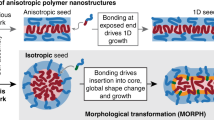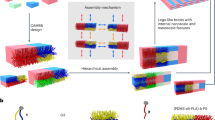Abstract
The incorporation of nanoparticles into polymers is a design approach that is used in many areas of materials science1,2. The concept is attractive because it enables the creation of materials with new or improved properties by mixing multiple constituents and exploiting synergistic effects. One important technological thrust is the development of structural materials with improved mechanical and thermal characteristics3,4. Equally intriguing is the possibility to design functional materials5 with unique optical6,7 or electronic properties8,9, catalytic activity10 or selective permeation11,12. The broad technological exploitation of polymer nanocomposites is, however, stifled by the lack of effective methods to control nanoparticle dispersion13,14,15. We report a simple and versatile process for the formation of homogeneous polymer/nanofibre composites. The approach is based on the formation of a three-dimensional template of well-individualized nanofibres, which is filled with any polymer of choice. We demonstrate that this template approach is broadly applicable and allows for the fabrication of otherwise inaccessible nanocomposites of immiscible components.
This is a preview of subscription content, access via your institution
Access options
Subscribe to this journal
Receive 12 print issues and online access
$259.00 per year
only $21.58 per issue
Buy this article
- Purchase on Springer Link
- Instant access to full article PDF
Prices may be subject to local taxes which are calculated during checkout




Similar content being viewed by others
References
Ajayan, P. M., Schadler, L. S. & Braun, P. B. Nanocomposite Science and Technology (Wiley VCH, Weinheim, 2003).
Whitesides, G. M. Nanoscience, nanotechnology, and chemistry. Small 1, 172–179 (2005).
Kojima, Y. et al. Mechanical properties of nylon 6–clay hybrid. J. Mater. Res. 8, 1185–1189 (1993).
Bandi, S., Bell, M. & Schiraldi, D. A. Temperature-responsive clay aerogel–polymer composites. Macromolecules 38, 9216–9220 (2005).
Geckeler, K. & Rosenberg, E. (eds) Functional Nanomaterials (American Scientific Publisher, Valencia, USA, 2006).
Ziolo, R. F. et al. Matrix-mediated synthesis of nanocrystalline gamma-Fe2O3—a new optically transparent magnetic material. Science 257, 219–223 (1992).
Hu, J. T. et al. Linearly polarized emission from colloidal semiconductor quantum rods. Science 292, 2060–2063 (2001).
Sariciftci, N. S., Smilowitz, L., Heeger, A. J. & Wudl, F. Photoinduced electron-transfer from a conducting polymer to buckminsterfullerene. Science 258, 1474–1476 (1992).
Stankovich, S. et al. Graphene-based composite materials. Nature 442, 282–286 (2006).
Bashyam, R. & Zelenay, P. A class of non-precious metal composite catalysts for fuel cells. Nature 443, 63–66 (2006).
Merkel, T. C. et al. Ultrapermeable, reverse-selective nanocomposite membranes. Science 296, 519–522 (2002).
Hinds, B. J. et al. Aligned multiwalled carbon nanotube membranes. Science 303, 62–65 (2004).
Lin, Y. et al. Self-directed self-assembly of nanoparticle/copolymer mixtures. Nature 434, 55–59 (2005).
Mackay, M. E. et al. General strategies for nanoparticle dispersion. Science 311, 1740–1743 (2006).
Balazs, A. C., Emrick, T. & Russell, T. P. Nanoparticle polymer composites: Where two small worlds meet. Science 314, 1107–1110 (2006).
Gupta, S. et al. Entropy-driven segregation of nanoparticles to cracks in multilayered composite polymer structures. Nature Mater. 5, 229–233 (2006).
de Souza Lima, M. M. & Borsali, R. Rodlike cellulose microcrystals: structure, properties, and applications. Macromol. Rapid Commun. 25, 771–778 (2004).
Samir, M. A. S. A., Alloin, F. & Dufresne, A. Review of recent research into cellulosic whiskers, their properties and their application in nanocomposite field. Biomacromolecules 6, 612–626 (2005).
Marchessault, R. H., Morehead, F. F. & Walter, N. M. Liquid crystal systems from fibrillar polysaccharides. Nature 184, 632–633 (1959).
Sturcova, A., Davies, J. R. & Eichhorn, S. J. Elastic modulus and stress-transfer properties of tunicate cellulose whiskers. Biomacromolecules 6, 1055–1061 (2005).
van den Berg, O., Capadona, J. R. & Weder, C. Preparation of homogeneous dispersions of tunicate cellulose whiskers in organic solvents. Biomacromolecules 8, 1353–1357 (2007).
Kuga, S., Kim, D. Y., Nishiyama, Y. & Brown, R. M. Nanofibrillar carbon from native cellulose. Mol. Cryst. Liq. Cryst. 387, 13–19 (2002).
Ljungberg, N. B., Bortolussi, F., Boisson, C., Heux, L. & Cavaillé, J. Y. New nanocomposite materials reinforced with cellulose whiskers in atactic polypropylene: effect of surface and dispersion characteristics. Biomacromolecules 6, 2732–2739 (2005).
Huang, Y., Yang, Y. Q. & Petermann, J. Atomic force microscopy on ethyl-cyanoethyl cellulose/polyacrylic acid composites with cholesteric order. Polymer 39, 5301–5306 (1998).
Schroers, M., Kokil, A. & Weder, C. Solid polymer electrolytes based on nanocomposites of ethylene oxide–epichlorohydrin copolymers and cellulose whiskers. J. Appl. Polym. Sci. 93, 2883–2888 (2004).
Takayanagi, M., Uemura, S. & Minami, S. Application of equivalent model method to dynamic rheo-optical properties of crystalline polymer. J. Polym. Sci. C 5, 113–122 (1964).
Ouali, N., Cavaillé, J. Y. & Pérez, J. Elastic, viscoelastic and plastic behavior of multiphase polymer blends. Plast. Rubber Comp. Process. Appl. 16, 55–60 (1991).
Dong, X. M., Kimura, T., Revol, J.-F. & Gray, D. G. Effects of ion strength on the isotropic-chiral nematic phase transition of suspensions of cellulose crystallites. Langmuir 12, 2076–2082 (1996).
Yamanaka, S. et al. The structure and mechanical properties of sheets prepared from bacterial cellulose. J. Mater. Sci. 24, 3141–3145 (1989).
Bryning, M. B. et al. Carbon nanotube aerogels. Adv. Mater. 19, 661–664.
Sen, R. et al. Preparation of single-walled carbon nanotube reinforced polystyrene and polyurethane nanofibres and membranes by electrospinning. Nano Lett. 4, 459–464 (2004).
Blake, R. et al. Reinforcement of poly(vinyl chloride) and polystyrene using chlorinated polypropylene grafted carbon nanotubes. J. Mater. Chem. 16, 4206–4213 (2006).
Morales-Teyssier, O., Sanchez-Valdes, S. & Ramos-de Valle, L. F. Effect of carbon nanofiber functionalization on the dispersion and physical and mechanical properties of polystyrene nanocomposites. Macromol. Mater. Eng. 219, 1547–1555 (2006).
Chang, T.-E., Kisliuk, A., Rhodes, S. M., Brittain, W. J. & Sokolov, A. P. Conductivity and mechanical properties of well-dispersed single-wall carbon nanotube/polystyrene composite. Polymer 47, 7740–7746 (2006).
Wang, Z., Lu, M., Li, H.-U. & Guo, X.-Y. SWNTs–polystyrene composites preparation and electrical properties research. Mater. Chem. Phys. 100, 77–81 (2006).
Sun, C. True density of microcrystalline cellulose. J. Pharm. Sci. 94, 2132–2134 (2005).
Gere, J. M. & Timoshenko, S. P. Mechanics of Materials 3rd edn (Pearson Higher Education, New Jersey, 1990).
Acknowledgements
We thank L. McCorkle, M. Hitomi, H. Kahn and J.D. Mendez for help with the SEM, preparation of ultramicrotomed samples, AFM characterization, and conductivity measurements, respectively. We also thank S. Trittschuh and K. Shanmuganathan for their help with the preparation of cotton cellulose nanocrystals. Generous financial support from the Case School of Engineering (Presidential Research Initiative), the L. Stokes Cleveland VAMC Advanced Platform Technology Center, the Department of Veteran's Affairs Associate Investigator Career Development Program, and NIH under grant number R21NS053798-01 is gratefully acknowledged.
Author information
Authors and Affiliations
Contributions
J.C., O.V., S.R. and C.W. conceived the approach and designed the experiments, J.C., O.V. and L.C. performed the experiments, J.C., O.V., M.S., D.T., S.R. and C.W. analysed and interpreted the data, and J.C., S.R. and C.W. wrote the paper.
Corresponding author
Ethics declarations
Competing interests
A provisional US patent application on the process used in the paper was filed by Case Western Reserve University.
Supplementary information
Supplementary Information
Supplementary methods, supplementary figures S1–S9 and supplementary tables 1 and 2 (PDF 507 kb)
Rights and permissions
About this article
Cite this article
Capadona, J., Van Den Berg, O., Capadona, L. et al. A versatile approach for the processing of polymer nanocomposites with self-assembled nanofibre templates. Nature Nanotech 2, 765–769 (2007). https://doi.org/10.1038/nnano.2007.379
Received:
Accepted:
Published:
Issue Date:
DOI: https://doi.org/10.1038/nnano.2007.379
This article is cited by
-
“Greener” homogeneous esterification of cellulose isolated from Stipa tenacissima plant located in the Eastern region of Morocco using ionic liquids as reaction medium
Polymer Bulletin (2023)
-
Life cycle assessment of manufacturing cellulose nanofibril-reinforced chitosan composite films for packaging applications
The International Journal of Life Cycle Assessment (2022)
-
Manganese ferrite—polyaniline nanocomposites for microwave absorbers in X band
Journal of Materials Science: Materials in Electronics (2022)
-
Irregular and suppressed elastic deformation by a structural twist in cellulose nanofibre models
Scientific Reports (2021)
-
Natural rubber composites with Grits waste from cellulose industry
Journal of Material Cycles and Waste Management (2020)



